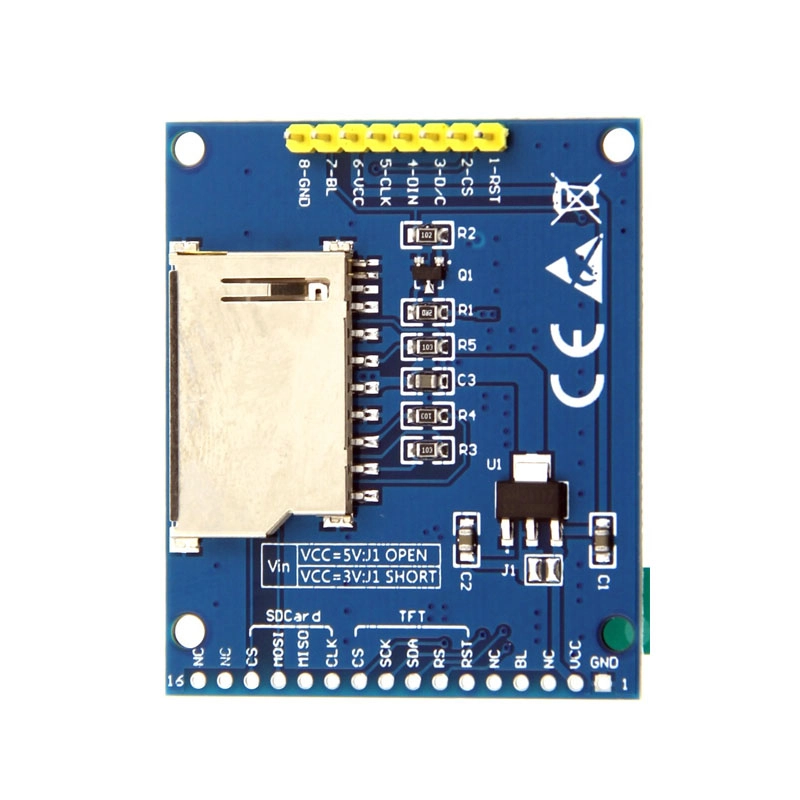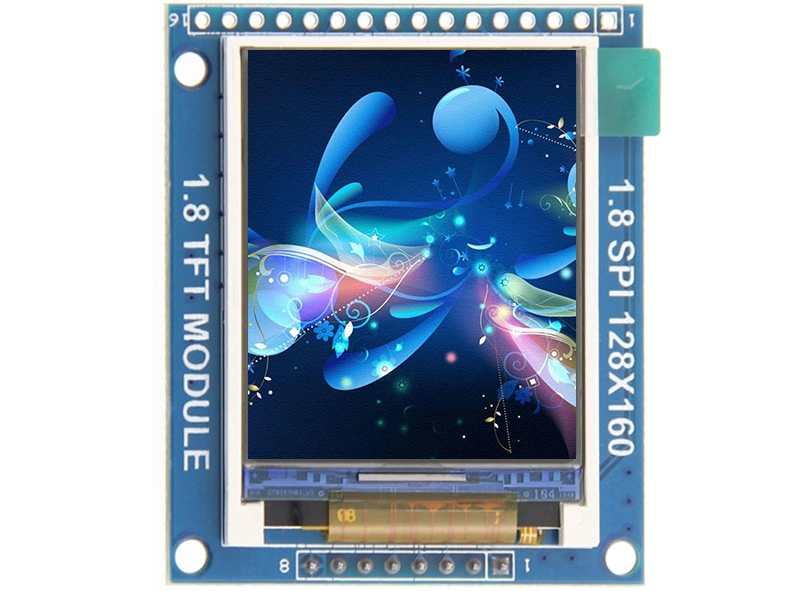Arduino TFT displays offer an excellent method to incorporate visuals and interactivity into projects, yet they occasionally pose difficulties. From power outages to warped hues, connection mishaps, and touchscreen alignment troubles, resolving these concerns swiftly can spare time and irritation. This manual addresses frequent problems with TFT Arduino displays, their origins, and detailed solutions to assist users in getting their screens operating correctly.
Understanding Common Arduino TFT Display Issues
Why Arduino TFT Displays Fail to Power On
A widespread challenge with TFT Arduino displays is that they refuse to activate. Indicators include a totally empty screen, a wavering backlight, or no evidence of energy whatsoever. This difficulty often stems from improper wiring, inadequate energy supply, or mismatched voltage levels.
To tackle this problem, initially confirm that the display is accurately linked to the Arduino board. Make sure the GND and VCC connections are firm, and ascertain that the display obtains the appropriate voltage. Certain TFT modules demand 3.3V rather than 5V, so employing an incorrect energy source can stop the display from working. If the energy supply falls short, attempt using an external power provider instead of relying solely on the Arduino’s power.
Fixing Distorted Colors or Pixelation
Warped hues, pixelation, or erroneous image depiction typically arise from software-related glitches. A frequent reason is an inaccurate initialization process within the code. If the TFT display isn’t correctly set up in the Arduino sketch, colors might seem reversed, faded, or out of place.
To correct this, verify that the appropriate display driver library is in use. Libraries such as Adafruit GFX and UTFT offer pre-set configurations for various TFT modules. If color troubles linger, tweak the SPI clock pace in the code. An overly rapid clock pace can trigger pixel mistakes, whereas a wrong color bit depth choice might lead to flawed rendering. Slowing the SPI pace and confirming the right 16-bit or 24-bit color setting can enhance image precision.
Resolving Touchscreen Calibration Problems
For TFT modules equipped with touch capabilities, sluggish or imprecise touch recognition can be exasperating. At times, touch inputs deviate by a few pixels. Alternatively, the display might entirely fail to detect touch movements.
To realign the touchscreen, employ built-in calibration features found in libraries like XPT2046. These features enable users to refine the touch detection framework and boost accuracy. If calibration doesn’t solve the issue, inspect for physical harm. A fractured or scratched touchscreen can interrupt electrical impulses, hindering the panel’s ability to accurately sense touches.
Debugging Communication Errors with TFT Arduino Displays
Troubleshooting SPI Communication Errors
Most TFT Arduino displays rely on SPI (Serial Peripheral Interface) to interact with the microcontroller. If the screen shows nothing despite proper connections, the problem might lie in SPI communication.
Start by examining the SCK (Serial Clock), MOSI (Master Out Slave In), and CS (Chip Select) pins to ensure they’re properly attached. Unstable or loose links can block data from reaching the display. A logic analyzer can help evaluate signal strength and pinpoint possible transfer errors.
Solving "No Library Found" Errors
Numerous TFT displays depend on specific libraries to work effectively. If the Arduino IDE flags an error noting that no library is detected, it suggests the necessary software is either absent or obsolete.
To remedy this, install the required TFT display libraries, such as Adafruit_GFX, UTFT, or TFT_eSPI, via the Arduino Library Manager. Always confirm that the right driver aligns with the particular display model. If an error continues, look for clashes among multiple libraries and eliminate duplicates from the Arduino libraries directory.
Overcoming Screen Freezing or Lag
A TFT Arduino display might stall or respond slowly because of inefficient coding or excessive memory demands. If the display lags, the loop() function could be overwhelming the processor with constant updates.
Enhancing the display buffer can cut memory use and lift performance. Utilizing hardware-driven graphics acceleration in libraries like TFT_eSPI can also quicken rendering. Moreover, cutting back on frequent screen refreshes over a brief span keeps the display from becoming overloaded.
Advanced Fixes for Persistent TFT Arduino TFT Displays Problems

Addressing Backlight Failures
If the display looks exceptionally faint or utterly dark, the backlight might have malfunctioned. To diagnose this, test the backlight circuit with a multimeter to determine if it’s receiving energy. If the circuit remains intact yet the LEDs refuse to glow, the LED backlight driver or resistor could be defective and require swapping out.
Repairing Physical Damage to TFT Arduino TFT Displays Modules
Unintentional drops, undue pressure, or moisture exposure can inflict physical harm on a TFT Arduino display. Evidence of damage includes a shattered glass surface, detached connectors, or moisture marks within the display layers.
In certain instances, reattaching loose ribbon cables can resolve display troubles. However, for broken glass or water damage, replacing the entire display unit is often the wisest choice. If the harm is confined to one part, like the touch layer, substituting just that piece might suffice instead of replacing the whole screen.
Customizing Arduino TFT Displays Displays for Complex Projects
Standard TFT Arduino displays might not always fulfill the needs of particular tasks. For sophisticated projects, adjustments such as unique interface tweaks, PCB alterations, and optical bonding can elevate performance.
For endeavors needing customized display solutions, Displaysell’s TFT Arduino Display Customization Service delivers engineering know-how in touchscreen merging, adaptable connectors, and high-luminosity panels. These enhancements optimize displays for industrial, medical, and commercial uses where exactness and resilience are vital.
Proactive Maintenance for Arduino TFT Displays
Best Practices to Extend Arduino TFT Displays Display Lifespan
Proper upkeep can prolong the durability of a TFT Arduino display and ward off typical breakdowns. To shield against static electricity damage, always manage the display with anti-static gloves or wristbands. Keep the screen clear of extreme heat or cold, as intense temperatures can weaken liquid crystals and bonding agents.
Routinely wiping the display prevents dust accumulation, which might impair touchscreen sensitivity. Use a microfiber cloth and gentle cleaning solutions to clean the screen without risking scratches or harm.
Firmware Updates and Compatibility Checks
Maintaining up-to-date firmware and libraries ensures the TFT Arduino display stays aligned with the newest software editions. The Arduino IDE and TFT driver libraries often receive updates introducing fresh features and fixes for glitches.
To cautiously test new firmware, back up current settings before proceeding with an update. Testing beta versions in a separate setup can avoid unintended disruptions in active projects. Verifying compatibility prior to upgrading sidesteps unforeseen complications.
Frequently Asked Questions (FAQs)
Q: Why is my TFT Arduino display not turning on even with correct wiring?
A: Inspect the voltage needs. Some TFT displays run on 3.3V, while others need 5V. A mismatched power source can halt the display’s operation.
Q: How do I fix flickering lines on my TFT screen?
A: Flickering might stem from rapid SPI clock speeds or unsteady power. Reduce the SPI clock rate in the code. Also, add a decoupling capacitor near the power input to steady voltage swings.
Q: Can I use any TFT library with my Arduino display?
A: No, the library must correspond to the display controller. Typical controllers include ILI9341 and ST7735. An incompatible library can stop the screen from showing properly.
Q: What causes touchscreen inaccuracies on TFT modules?
A: Touch troubles might arise from calibration slip-ups, dust buildup, or uneven force on the screen. Performing a calibration routine and cleaning the display can sharpen accuracy.
Final Thoughts: Get the Most Out of Your Arduino TFT Display
Troubleshooting a TFT Arduino display demands a methodical process, from inspecting power and communication links to refining software adjustments. Whether correcting backlight breakdowns, resolving SPI glitches, or enhancing touchscreen precision, grasping how these displays function simplifies problem-solving.
For advanced tasks requiring tailored TFT solutions, Displaysell’s engineering crew provides mastery in custom display tweaks, specialized connectors, and high-performance touchscreen panels. Reach out Displaysell today to explore how we can elevate your Arduino-based display endeavor!
